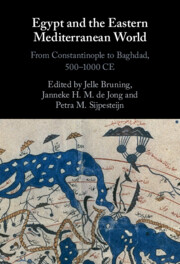Book contents
- Egypt and the Eastern Mediterranean World
- Egypt and the Eastern Mediterranean World
- Copyright page
- Contents
- Figures, Graphs, and Tables
- Notes on Contributors
- Notes on Transliteration, Names, and Dates
- Preface and Acknowledgments
- Additional material
- Introduction
- Part I Political and Administrative Connections
- Part II Economic Connections
- Chapter 7 Between Ramla and Fusṭāṭ: Archaeological Evidence for Egyptian Contacts with Early Islamic Palestine (Eighth–Eleventh Centuries)
- Chapter 8 Egypt’s Connections in the Early Caliphate: Political, Economic, and Cultural
- Chapter 9 Trading Activities in the Eastern Mediterranean through Ceramics between Late Antiquity and Fatimid Times (Seventh–Tenth/Eleventh Centuries)
- Part III Social and Cultural Connections
- Index
- References
Chapter 8 - Egypt’s Connections in the Early Caliphate: Political, Economic, and Cultural
from Part II - Economic Connections
Published online by Cambridge University Press: 01 December 2022
- Egypt and the Eastern Mediterranean World
- Egypt and the Eastern Mediterranean World
- Copyright page
- Contents
- Figures, Graphs, and Tables
- Notes on Contributors
- Notes on Transliteration, Names, and Dates
- Preface and Acknowledgments
- Additional material
- Introduction
- Part I Political and Administrative Connections
- Part II Economic Connections
- Chapter 7 Between Ramla and Fusṭāṭ: Archaeological Evidence for Egyptian Contacts with Early Islamic Palestine (Eighth–Eleventh Centuries)
- Chapter 8 Egypt’s Connections in the Early Caliphate: Political, Economic, and Cultural
- Chapter 9 Trading Activities in the Eastern Mediterranean through Ceramics between Late Antiquity and Fatimid Times (Seventh–Tenth/Eleventh Centuries)
- Part III Social and Cultural Connections
- Index
- References
Summary
Egypt’s position in the caliphate has generally been considered either as loosely tributary, with its governors running the province more or less as a personal possession, granting the caliph a share of the province’s riches, as it pleased them, or as the outer rim of a radial system extending from the caliph’s capital and through which caliphal power was exercised by means of administrative control and military force. In this model – which looks from the center outwards – Egypt is located at the decision-making periphery of the Muslim empire, the recipient of directives and consumer of developments initiated at the imperial capital (first located in Medina, then Damascus, and finally Baghdad), where the sneezes that precipitated all of the caliphate’s colds occurred.
This chapter takes a different view. By examining Egypt’s relationship to the imperial center between the Arab conquest and the establishment of the Fatimid caliphate in Cairo in 969 CE, and the complex, ambiguous, and shifting processes of interdependency, caliphal ambition, and local self-assertion as they appear in the sources, I will argue that at all times Egypt’s centrality to the caliphate was a two-way relationship, in which Egypt occupied a key place in caliphal strategic thinking, and in which Egyptians saw themselves as intrinsic to the Muslim imperial project.
- Type
- Chapter
- Information
- Egypt and the Eastern Mediterranean WorldFrom Constantinople to Baghdad, 500-1000 CE, pp. 238 - 271Publisher: Cambridge University PressPrint publication year: 2022
References
- 2
- Cited by



